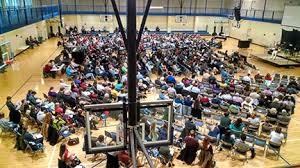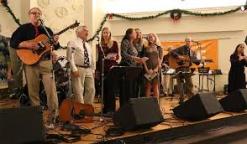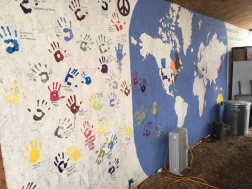 This is the first of four posts profiling Floridians affected by restorative justice.
This is the first of four posts profiling Floridians affected by restorative justice.
The social graciousness of an evening with the Grosmaire and McBride families is so perfect; it’s like stepping into a Douglas Sirk movie. Kate provided the venue. “We’ll meet at our house because Andy has a deacon meeting at church and won’t be home until late.” Julie and Michael brought the food. “These look sweet, but are actually savory,” Julie explained as she passed a platter of toast points. Kate showed off her blue ribbon winning wax block. We discussed the changing pattern of deer sightings in their wooded neighborhood.
 Supper was hearty soup with crusty bread and crisp salad. When Andy arrived we pulled another chair up to the table. When the McBride’s son, Conor, called during dinner everyone chimed in on the events of his day and his prospects for a new job.
Supper was hearty soup with crusty bread and crisp salad. When Andy arrived we pulled another chair up to the table. When the McBride’s son, Conor, called during dinner everyone chimed in on the events of his day and his prospects for a new job.
The evening’s anecdotes of rescue dogs and honeybees were so comfortable, these two couples such obviously long and good friends, I finally stopped searching for the melodrama foreshadowed in every Douglas Sirk film. The sordid event that brought these couples close does not lurk beneath the surface. They have brought it into the light, acknowledged it, addressed it, and forgiven it. Which enables the Grosmaire’s and McBride’s to move beyond the worst day of their lives.
Six years ago, Conor McBride killed his girlfriend, Ann Grosmaire. Ann’s parents, Kate and Andy, found forgiveness in their hearts, expressed it to Conor and their community, interceded on behalf of the troubled young man, and championed the first case of restorative justice in the state of Florida. As a result, Conor is serving a twenty-year sentence for a crime that usually carries life, or execution.
Restorative justice turns our legal system on its head. Traditional criminal procedures freeze relationships at the point of the crime and isolate victims from perpetrators under the guise of protecting them. This hardens all parties. Criminals never fathom the consequences of their actions; victims never witness perpetrators’ remorse. Restorative justice brings perpetrators and victims together in structured settings to negotiate punishment and restitution. This does mean that punishment will be lighter. Rather, punishment can be more appropriate. Perpetrators are forced to confront their actions; victims have the opportunity to move beyond powerlessness.
 Restorative justice provided an avenue for the Grosmaire’s to forgive – not pardon – Conor. There was no precedent or structure within Florida’s penal system to do this. However, through a creative interpretation of the pre-plea conference, the Grosmaire’s, McBride’s, Conor, and a collection of attorneys and restorative justice advocates met face to face for five hours to discuss the young man’s fate. The result – a twenty-year sentence without probation and stipulations on community service and speaking about teen dating violence – is less creative than restorative justice might allow, yet is far different than any doled out to a murderer in Florida.
Restorative justice provided an avenue for the Grosmaire’s to forgive – not pardon – Conor. There was no precedent or structure within Florida’s penal system to do this. However, through a creative interpretation of the pre-plea conference, the Grosmaire’s, McBride’s, Conor, and a collection of attorneys and restorative justice advocates met face to face for five hours to discuss the young man’s fate. The result – a twenty-year sentence without probation and stipulations on community service and speaking about teen dating violence – is less creative than restorative justice might allow, yet is far different than any doled out to a murderer in Florida.
Conor is not the only person who’s benefitted. All of the parents have also found strength and peace through forgiveness. Ann’s murder can never be atoned, but the Grosmaire’s believe rancor and revenge would only fuel the hole that Conor’s bullet shot through both families. By choosing to forgive, Kate and Andy refuse to be collateral victims of his violence. The process also eases Julie and Michael’s isolating burden as parents of a murderer. They recognize that Conor’s crime does not just affect one young woman and one young man. It reflects our culture and affects the entire community.
How will we live tomorrow?
 “I change the question to how can we live tomorrow. The Grosmaire’s took a stand on restorative justice that affects our whole community. It affects the victim, the perpetrator. They have unlocked the door for a new, more just way to live.” – Michael
“I change the question to how can we live tomorrow. The Grosmaire’s took a stand on restorative justice that affects our whole community. It affects the victim, the perpetrator. They have unlocked the door for a new, more just way to live.” – Michael












































